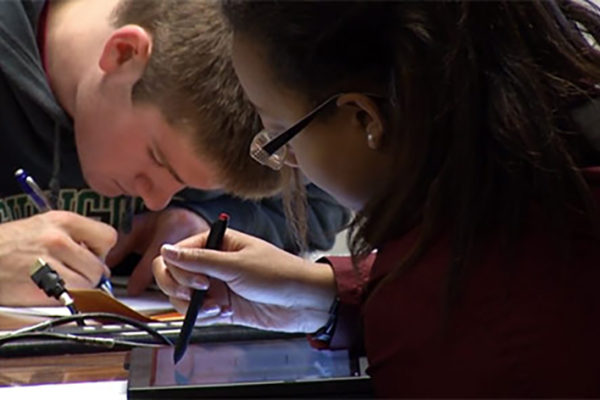Can large introductory science courses teach students to learn effectively?
In the past 10 years an active-learning course, called “Active Physics,” has gradually displaced lecture-based introductory courses in physics at Washington University in St. Louis. But are active-learning techniques effective when they are scaled up to large classes? A comprehensive three-year evaluation suggests that “Active Physics” consistently produces more proficient and confident students than the lecture courses it is replacing.
Active-Learning Classroom blends old and new to promote student learning
The Active-Learning Classroom (ALC) opened in fall 2012 on the lower level of Eads Hall as a pilot program. The classroom is a highly flexible space that facilitates collaborative group work as well as class discussions. The pilot program was such a success, it is hoped that additional active-learning classrooms will be designed throughout the Danforth Campus.
Brown School conducts experiment with active learning classroom
Over spring break, Room 37 in the Brown School’s Goldfarb Hall was transformed. For the last eight weeks of the semester, Brown School students in 15 courses took part in an experiment in pedagogy that brings teaching — and learning — into a new era. This isn’t your parents’ lecture hall. Say hello to the wired world of interactive instruction — or active learning.
A WUSTL undergraduate may have written that Wikipedia article you’re reading
This fall Joan Strassmann, PhD, professor of biology in Arts & Sciences taught a course in behavior ecology that was also an official Wikipedia course that required students both to edit an existing Wikipedia entry and then either add 25
references and 2500 words to a second entries or to create new ones. “No work by students as good as Washington University’s students should ever end up
in a professor’s drawer,” said Strassmann. “It was their responsibility
as smart people who were getting a great education to help others.”
Grant helps WUSTL computer science faculty emphasize active learning
Computer science faculty are exposing their undergraduate students to learning in ways that prepare them for interaction in the real work place. It’s not about “staying between the lines,” but more about getting out of your seat, moving around and interacting with your classmates. It’s called active learning, a learning-laboratory-based tutorial teaching concept.
New direction in teaching computer science emphasizes activity, interaction, critique
Computer science faculty at Washington University in St. Louis are exposing their undergraduate students to learning in ways that prepare them for interaction in the real work place. It’s not about “staying between the lines,” but more about getting out of your seat, moving around and interacting with your classmates. It’s called active learning, a learning-laboratory- based tutorial teaching concept.
Active learning to transform undergraduate education in WUSTL computer science and engineering
Timothy Trinidad leads a discussion with classmates (from left) David Schainker, Helena Wotring and Mamta Datwani. The students are part of a computer science engineering course taught by Burchan Bayazit, Ph.D., assistant professor of computer science and engineering. The course stresses “active learning,” and features group work, presentation skill and critiques.Kenneth J. Goldman, Ph.D., associate professor of computer science and engineering, is the recipient of a $562,000 grant from the National Science Foundation that will enable his department to transform undergraduate teaching methodology. Goldman and his fellow principal investigators are working to cultivate “active learning” in the classroom, with a significant increase in studio courses that involve team projects and interdisciplinary collaboration. In a culture marked by frequent critique, students will refine their design skills, as well as improve their ability to present and justify their designs and work in groups. Passive learning, typified by the traditional lecture, will be put on the backburner, though the flame will still burn low.

